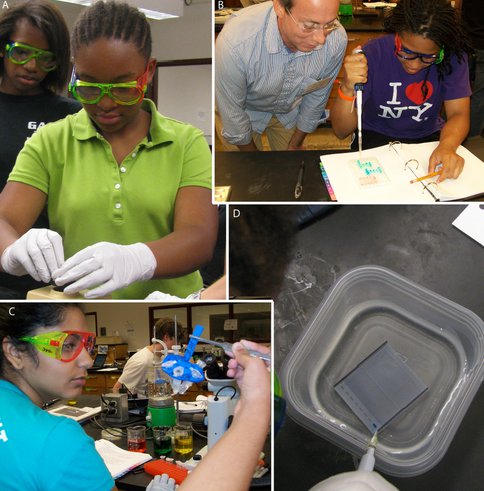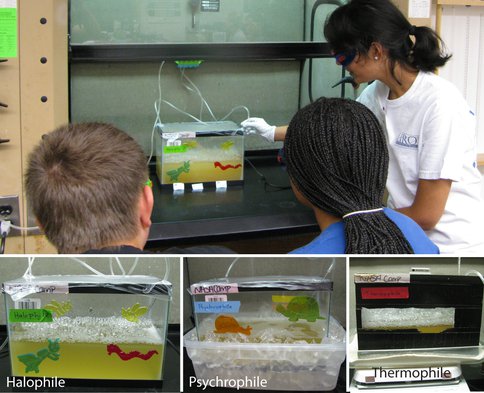2012 Annual Science Report
 Georgia Institute of Technology
Reporting | SEP 2011 – AUG 2012
Georgia Institute of Technology
Reporting | SEP 2011 – AUG 2012
Life on the Edge: Astrobiology Summer Learning Program
Project Summary
For the fourth year in a row, the Georgia Tech Team ran a one-week, non-residential Summer Learning Program (SLP), called Life on the Edge: Astrobiology. This year 20 high school students from the Atlanta metro area participated in the SLP. The GT Team recruited a high school Biology teacher and a high school Chemistry teacher teacher into the Georgia Intern Fellowship for Teachers program (GIFT, https://www.ceismc.gatech.edu/gift). The teachers this year were from the DeKalb County School System, one of the most diverse systems in the state of Georgia serving over 100,000 students; 75% are African American, 8% Hispanic, and 66% qualify for free and reduced lunch. In an effort to promote and encourage entry into science teaching careers, the GT Team paired the teachers with two Georgia Tech undergraduate students (biology majors), through the NSF sponsored “Tech to Teaching” Program (http://nsf-i3.org/projects/view/tech_to_teaching/). The teachers and undergraduate students collaborated over the summer with GT team members to prepare and develop, conduct, document, scrutinize and analyze the SLP. They updated and improved the previous years experiments, and ensured and documented that the program is aligned with the Georgia Performance Standards in Biology. Using materials from our previous camps, the teachers and the undergraduate students prepared student and teacher guides for the 2012 SLP. They worked with GT team members, in their laboratories, to prepare the SLP experiments. The teachers and undergraduate students, actually ran the camp, with participation from other GT team members.
Project Progress
1. Life on the Edge: Summer Learning Program for High School Students
For the fourth year in a row, the Georgia Tech Team ran a one-week, non-residential Summer Learning Program (SLP), called Life on the Edge: Astrobiology. This year 20 high school students from the Atlanta metro area participated in the SLP. The GT Team recruited a high school Biology teacher and a high school Chemistry teacher teacher into the Georgia Intern Fellowship for Teachers program (GIFT, https://www.ceismc.gatech.edu/gift). The teachers this year were from the DeKalb County School System, one of the most diverse systems in the state of Georgia serving over 100,000 students; 75% are African American, 8% Hispanic, and 66% qualify for free and reduced lunch. In an effort to promote and encourage entry into science teaching careers, the GT Team paired the teachers with two Georgia Tech undergraduate students (biology majors), through the NSF sponsored “Tech to Teaching” Program (http://nsf-i3.org/projects/view/tech_to_teaching/). The teachers and undergraduate students collaborated over the summer with GT team members to prepare and develop, conduct, document, scrutinize and analyze the SLP. They updated and improved the previous years experiments, and ensured and documented that the program is aligned with the Georgia Performance Standards in Biology. Using materials from our previous camps, the teachers and the undergraduate students prepared student and teacher guides for the 2012 SLP. They worked with GT team members, in their laboratories, to prepare the SLP experiments. The teachers and undergraduate students, actually ran the camp, with participation from other GT team members.
The scientific focus of the SLP is life in extreme environments. The high school students (Figure 1) explored astrobiology, biochemistry, evolution, and molecular biology though art and intense, engaging, hands-on activities.
2012 Life on the Edge: Astrobiology Summer Learning Program participants and instructors
Life on the Edge provides teachers, undergraduates and high school students exposure to the excitement of astrobiology, and gives science and art teachers methods for incorporating astrobiology into their high school teaching programs. Basic biology concepts were reviewed and explained in an astrobiological context, to illustrate the adaptation and survival of many types of extremophiles and the diversity of environments that can support life. A variety of extremophiles are grown in the SLP lab, including halophiles, psychrophiles, and thermophiles. Each student uses biological techniques such as micropipetting, gel electrophoresis, Polymerase Chain Reaction (PCR), (Figure 2) to learn the methods used by astrobiology researchers.
Additional activities include: Exploring Titan’s low temperature environment, using liquid nitrogen, painting astrobiology inspired art growing extremophiles, attending lectures by the GT Center faculty and post doctoral students, desiccating and rehydrating rotifers, touring research labs and teaching facilities and presenting a group project in a final presentation that highlights the experimental investigation of halophiles, psychrophiles, and thermophiles.
Life on the Edge: Activities: Titan’s Temperature, lectures, creating art using repetitive stamping, and student presentations using the presentation tool Prezi.
An important goal of our SLP is to develop low cost/low tech astrobiology experiments and protocols that can be readily incorporated into high school laboratories, that are restrained by limited resources and expertise. The SLP explicitly avoids complex and expensive equipment and experiments and develops materials that are readily accessible to high school teachers. For example we have developed an aquarium-based system for growing extremophiles (sterile techniques are not required). Following our protocols, teachers can use aquaria and bubblers (<$40) to culture thermophiles (also requires a hotplate), halophiles, alkaliphiles, acidophiles and psychrophiles (also requires an ice chest). Several of these aquaria are shown in Figure 3.
In addition we have developed a PCR protocol that uses two water baths (on different two hot plates) and a stopwatch. In side-by-side comparisons by the high school students, the yield of our low tech PCR method is greater than that with an expensive gradient PCR machine.
During the SLP students also learn about evolution on a small scale. As organisms evolve, repetition and pattern can be seen in everything from the simple organism’s DNA to the complex organism’s specific adaptations allowing it to adjust to such harsh environments. Exploring astrobiology through a creative approach allows students to understand the importance of repetition, pattern, and unity in the origins of life itself. In an effort to implement a new teaching tool, an art project was included in the program. The purpose of this activity was to fuse aspects of astrobiology and art, specifically focusing on pattern, repetition and unity. Students were able to understand and apply the visual composition of chemical fingerprints of molecules and minerals found in space as well as understand the meaning of pattern and the importance of repetition on both a scientific and an artistic level.
Samples of astrobiology inspired art using stamps designed by the Life on the Edge summer students: Curiosity’s 7 minutes of terror, Saturn and Titan, and DNA.
Several evaluation techniques were used to access student learning from the Life on the Edge: Astrobiology SLP. These included pre and post data analysis. The survey results from the SLP indicate that the participants increased their content knowledge about DNA, extremophiles, describing rotifers and Titan’s environments, and analyzing experimental data. Specifically, students were asked to indicate how confident they felt in using, describing, and defining scientific data, methods, and tools.
The Astrobiology program also fostered an interest in high school education for two Georgia Tech students involved in the NSF funded Pre- Teaching Summer Undergraduate Research Experience Program: Ms. Aakanksha Angra received her B.S. in Biology from Georgia Tech and is now pursuing a Ph.D. in Ecology and Biology Education at Purdue University under the guidance of Dr. Nancy Pelaez. Ms. Allison Dowell is graduating with her B.S. in Science, Technology, and Culture from Georgia Tech in December.
2. Astrobiology inspired art in high school art curriculum: Students teaching students
Mrs. Janetta Greenwood, a Biology and Applications of Biotechnology teacher and Ms. Claire Zimmerman, an Art teacher at Dunwoody High School collaborated to infuse art and science into their classrooms. The biology students visited the art class to teach them about the origins of life. The art students were introduced to the various theories on how life began such as primordial soup, bubble model theory, and deep sea vents theory and how these theories are relevant to why we are currently looking for signs of life on Mars and other places in our solar system. Once the art students completed their astrobiology inspired pieces, they visited the biology class and taught them how to create their art using rubber stamps and create an artistic way to display their concept.
Samples of art pieces created by Dunwoody High School art and science students and inspired by astrobiology.
3. Astrobiology art lesson plans
Lesson plans for a high school art class were developed to fuse aspects of astrobiology and art, specifically focusing on pattern, repetition and unity. These lessons will help students understand and apply the visual composition of chemical fingerprints of molecules and minerals found in space as well as understand the meaning of pattern and the importance of repetition on both a scientific and an artistic level.
One activity developed and implemented was a stamp art project. Prior to stamping, students were asked to research astrobiology concepts for inspiration. Students were then prompted to sketch their design on paper before re-drawing on the eraser and carving with the X-Acto® knife. Using tempera paint, students then stamped the design onto the grid paper.
Artist statement (Claire Zimmerman, Figure 3, Top Right): The symbol I chose was that for water: H20. In learning about Astrobiology, the importance that water fulfills in hosting life is evident. Scientists have been able to find life in nearly every environment on Earth that has water. This suggests that life has the ability to adapt to any environment as long as it has water. These observations serve as the theme “follow the water” which guides NASA in its search for extraterrestrial life. By creating a stamp of the water symbol, I was able to visually connect the importance of water in the search for life by repeating the pattern throughout the piece – signifying the repeating structure of H20 in water as well as the distribution of water itself throughout the universe. The colors I chose reflect the colors of the ice sheet found surrounding Europa and this in turn provokes us to question how deep life would have to be hiding in order to be surrounded by liquid water and survive on this frozen satellite.
NEW: Education and Public Outreach Presentations (4):
Aakanksha Angra, Allison Dowell, Janetta Greenwood, Deanna Boyd, Tanya Mason, Claire Zimmerman, Pete Macaluso, Ryan Randall, Caitlin Prickett, Eric Anderson, Brande Jones, Jamila Cola, Eric Gaucher, Terry Snell, Loren Dean Williams, Applying the 5E Model to Astrobiology Summer Learning Program for High School Students, Society for the Advancement of Biology Education Research, Minneapolis, Minnesota July 13, 2012 (Poster)
Jamila Cola, J. Greenwood, Ryan N. Randall, Eric Gaucher, T. Snell, Loren Williams, Astrobiology Summer Learning Program for High School Students. Astrobiology Science Conference, Atlanta, Georgia, April 19, 2012 (Poster)
Jamila Cola, Brande L. Jones, T.P. Whelan, T. Docal, Astrobiology Self-Directed Course and the NASA Electronic Professional Development Network. Astrobiology Science Conference, Atlanta, Georgia, April 18, 2012 (Oral)
Jamila Cola, Eric Gaucher, Terry Snell, Janetta Greenwood, Aakanksha Angra, Claire Zimmerman, Loren Dean Williams, Summer Research Experiences for Science and Art Teachers to Explore Astrobiology, American Geophysical Union, San Franciso, CA, December 3, 2012 (Poster)
-
PROJECT INVESTIGATORS:
-
PROJECT MEMBERS:
Christine Dunham
Co-Investigator
Roger Wartell
Co-Investigator
Eric Anderson
Research Staff
Caitlin Prickett
Research Staff
Ryan Randall
Research Staff
Aakanksha Angra
Undergraduate Student
Peter Macaluso
Undergraduate Student
Deanna Boyd
Unspecified Role
Janetta Greenwood
Unspecified Role
-
RELATED OBJECTIVES:









